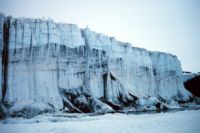Why the North Pole is So Icy

It might seem obvious that there should be a lot of ice near the North Pole. But scientists have struggled to explain why there is so much. A new study proposes an explanation.
A sudden fall in the average global temperature 2.7 million years ago caused the Arctic Ocean to freeze, researchers have known. Europe and North America got covered in ice, too. The cooling alone is not enough to explain why so much ice built up and has remained to this day in the far North, however.
Back then, another important climate change occurred. The difference between summer and winter temperatures changed by 13 degrees Fahrenheit (7 Celsius) within just a few centuries, the new research found.
Summer got warmer, and winter got colder. So more water evaporated from the sea during summer, making the air more humid. In turn, more snow fell in winter, and the enhanced frigidity allowed ice to build up.
The temperature shift was caused by an increase in freshwater flowing into the sea. Freshwater and saltwater do not mix well, so layers of different densities developed. In spring, the surface layer warmed as usual, but since it didn't mix well with the layer below, the warming was enhance during summer -- causing more evaporation than in millennia prior.
The study, detailed in the Feb. 24 issue of the journal Nature, was based on an analysis of marine fossils and computer climate models.
"Through this research we can understand in greater detail why climate change occurs, and more specifically, the role of the ocean in producing climate change," said study leader Antoni Rosell of the Universitat Autonoma de Barcelona. "This information will improve climate models used to predict how today's climate will change in the future."
Get the world’s most fascinating discoveries delivered straight to your inbox.



